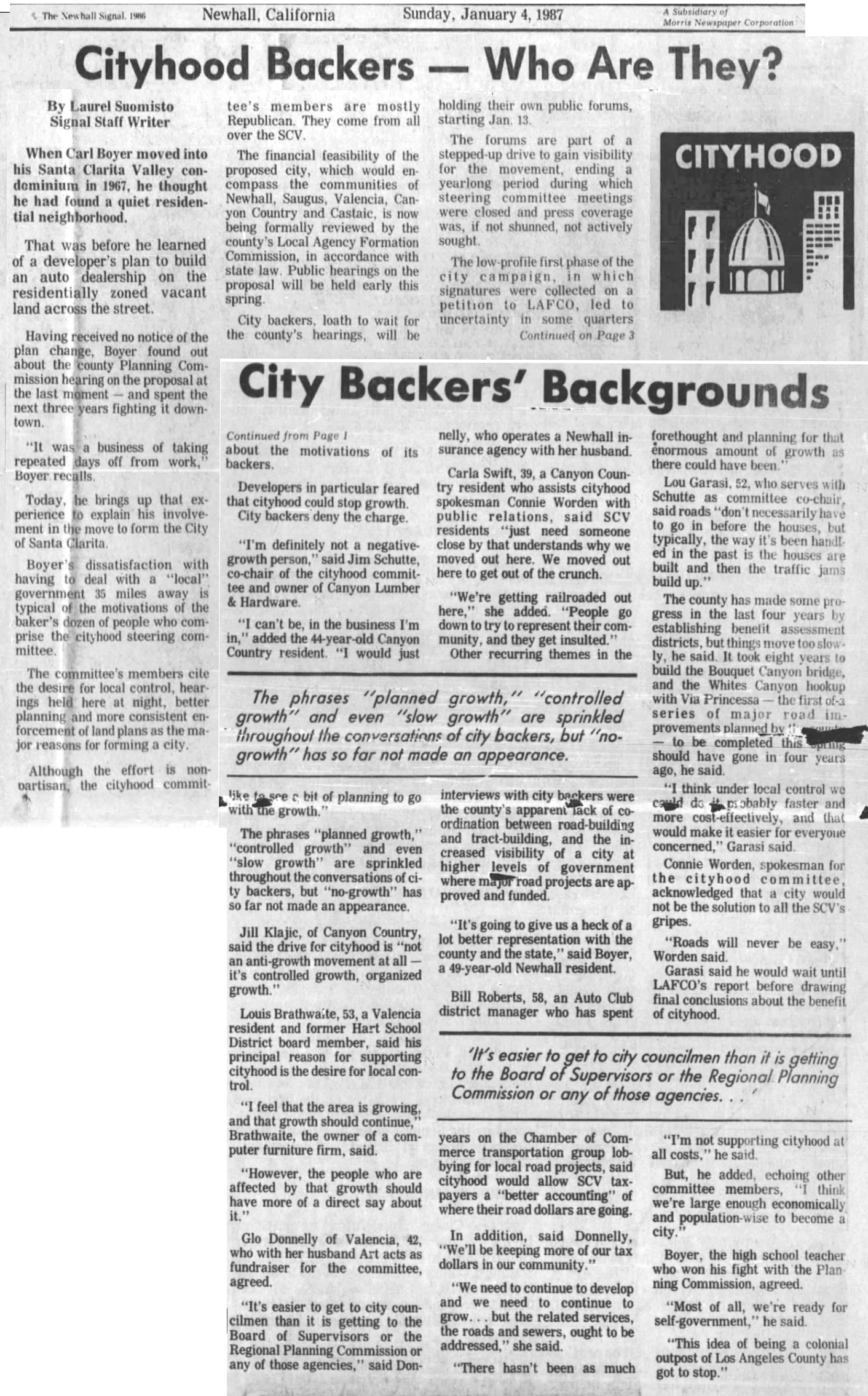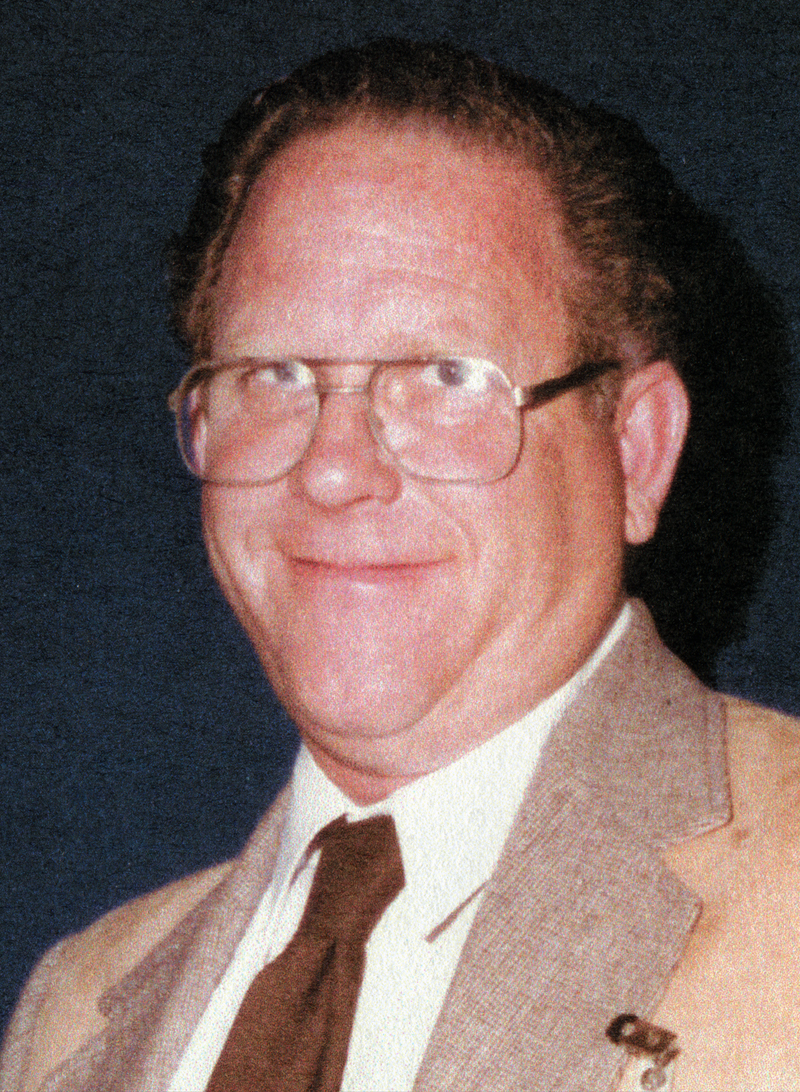Cityhood Backers — Who Are They?
The Newhall Signal and Saugus Enterprise | Sunday, January 4, 1987.

Click to enlarge.
|
When Carl Boyer moved into his Santa Clarita Valley condominium in 1967, he thought he had found a quiet residential neighborhood.
That was before he learned of a developer's plan to build an auto dealership on the residentially zoned vacant land across the street.
Having received no notice of the plan change, Boyer found out about the county Planning Commission hearing on the proposal at the last moment — and spent the next three years fighting it downtown
"It was a business of taking repeated days off from work," Boyer recalls.
Today, he brings up that experience to explain his involvement in the move to form the City of Santa Clarita.
Boyer's dissatisfaction with having to deal with a "local" government 35 miles away is typical of the motivations of the baker's dozen of people who comprise the cityhood steering committee.
The committee's members cite the desire for local control, hearings held here at night, better planning and more consistent enforcement of land plans as the major reasons for forming a city.
Although he effort is nonpartisan, the cityhood committee's members are mostly Republican. They come from all over the SCV.
The financial feasibility of the proposed city, which would encompass the communities of Newhall, Saugus, Valencia, Canyon Country and Castaic, is now being formally reviewed by the county's Local Agency Formation Commission, in accordance with state law. Public hearings on the proposal will be held early this spring.
City backers, loath to wait for the county's hearings, will be holding their own public forums, starting Jan 13.
The forums are part of a stepped up drive to gain visibility for the movement, ending a yearlong period during which steering committee meetings were closed and press coverage was, if not shunned, not actively sought.
The low-profile first phase of the city campaign, in which signatures were collected on a petition to LAFCO, led to uncertainty in some quarters about the motivations of its backers.
Developers in particular feared that cityhood could stop growth. City backers deny the charge.
"I'm definitely not a negative-growth person," said Jim Schutte, co-chair of the cityhood committee and owner of Canyon Lumber & Hardware.
"I can't be, in the business I'm in," added the 44-year-old Canyon Country resident. "I would just like to see a bit of planning to go with the growth."
The phrases "planned growth," "controlled growth" and even "slow growth" are sprinkled throughout the conversations of city backers, but "no-growth" has so far not made an appearance.
Jill Klajic, of Canyon Country, said the drive for cityhood is "not an anti-growth movement at all — it's controlled growth, organized growth."
Louis Brathwaite, 53, a Valencia resident and former Hart School District board member, said his principal reason for supporting cityhood is the desire for local control.
"I feel that the area is growing, and that growth should continue," Brathwaite, the owner of a computer furniture firm, said.
"However, the people who are affected by that growth should have more of a direct say about it."
Glo Donnelly of Valencia, 42, who with her husband Art acts as fundraiser for the committee, agreed.
"It's easier to get to city councilmen than it is getting to the Board of Supervisors or the Regional Planning Commission or any of those agencies," said Donnelly, who operates a Newhall insurance agency with her husband.
Carla Swift, 39, a Canyon Country resident who assists cityhood spokesman Connie Worden with public relations, said SCV residents "just need someone close by that understands why we moved out here. We moved out here to get out of the crunch.
"We're getting railroaded out here," she added. "People go down to try to represent their community, and they get insulted."
Other recurring themes in the interviews with city backers were the county's apparent lack of coordination between road-building and tract-building, and the increased visibility of a city at higher levels of government where major road projects are approved and funded.
"It's going to give us a heck of a lot better representation with the county and the state," said Boyer, a 49-year-old Newhall resident.
Bill Roberts, 58, an Auto Club district manager who has spent years on the Chamber of Commerce transportation group lobbying for local road projects, said cityhood would allow SCV taxpayers a "better accounting" of where their road dollars are going.
In addition, said Donnelly, "We'll be keeping more of our tax dollars in our community."
"We need to continue to develop and we need to continue to grow ... but the related services, the roads and sewers, ought to be addressed," she said.
"There hasn't been as much forethought and planning for that enormous amount of growth as there could have been."
Lou Garasi, 52, who serves with Schutte as committee co-chair, said roads "don't necessarily have to go in before the houses, but typically, the way it's been handled in the past is the houses are built and then the traffic jams build up."
The county has made some progress in the last four years by establishing benefit assessment districts, but things move too slowly, he said. It took eight years to build the Bouquet Canyon bridge, and the Whites Canyon hookup with Via Princessa — the first of a series of major road improvements planned by the county — to be completed this spring should have gone in four years ago, he said.
"I think under local control we could do it probably faster and more cost-effectively, and that would make it easier for everyone concerned," Garasi said.
Connie Worden, spokesman for the cityhood committee, acknowledged that a city would not be the solution to all the SCV's gripes.
"Roads will never be easy," Worden said.
Garasi said he would wait until LAFCO's report before drawing final conclusions about the benefit of cityhood.
"I'm not supporting cityhood at all costs," he said.
But, he added, echoing other committee members, "I think we're large enough economically and population-wise to become a city."
Boyer, the high school teacher who won his fight with the Planning Commission, agreed.
"Most of all, we're ready for self-government," he said.
"This idea of being a colonial outpost of Los Angeles County has got to stop."
| 



















